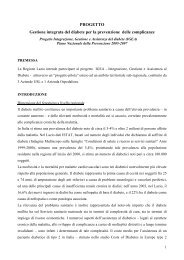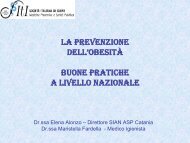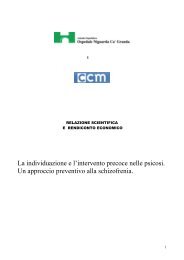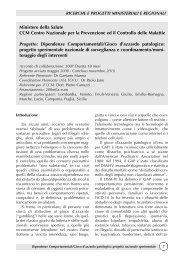Gaining health : analysis of policy development in European ...
Gaining health : analysis of policy development in European ...
Gaining health : analysis of policy development in European ...
Create successful ePaper yourself
Turn your PDF publications into a flip-book with our unique Google optimized e-Paper software.
Chapter 4<br />
58<br />
The employer, <strong>in</strong> both the public and private sector, is<br />
responsible for <strong>health</strong> and safety at the workplace and is<br />
required to organize and pay for preventive occupational<br />
<strong>health</strong> services for all workers regardless <strong>of</strong> the size, <strong>in</strong>dustrial<br />
sector or form <strong>of</strong> the enterprise. The provision <strong>of</strong><br />
curative services is voluntary but is <strong>in</strong>cluded <strong>in</strong> 80% <strong>of</strong> the<br />
service agreements. Some 92% <strong>of</strong> wage and salary earners<br />
are now covered for such care and about one third <strong>of</strong> outpatient<br />
medical care for people <strong>in</strong> employment is provided<br />
by the occupational <strong>health</strong> services. Jo<strong>in</strong><strong>in</strong>g the occupational<br />
<strong>health</strong> service system is voluntary for the self-employed,<br />
such as farmers.<br />
Occupational <strong>health</strong> services may be organized through<br />
municipal <strong>health</strong> centres or private medical centres or by<br />
the enterprise itself, alone or <strong>in</strong> collaboration with other<br />
enterprises. The aim is to assess dangers and hazards <strong>in</strong><br />
the workplace, prevent problems through early <strong>in</strong>tervention,<br />
promote <strong>health</strong> and the ability to work and develop<br />
the workplace community and environment. As <strong>in</strong>creas<strong>in</strong>g<br />
numbers <strong>of</strong> doctors prefer hospital or occupational <strong>health</strong><br />
work rather than PHC, there is some danger <strong>of</strong> a two-track<br />
system, with the employed be<strong>in</strong>g well and conveniently<br />
served, even <strong>in</strong> terms <strong>of</strong> their transfer to hospital care, and<br />
the PHC centres deal<strong>in</strong>g ma<strong>in</strong>ly with children and older<br />
people.<br />
The emphasis <strong>in</strong> occupational <strong>health</strong> care is on avoid<strong>in</strong>g<br />
occupational <strong>health</strong> risks, diseases and accidents and deal<strong>in</strong>g<br />
with problems related to physical and mental <strong>health</strong>. Nevertheless,<br />
lifestyle issues <strong>of</strong> importance to NCD are also<br />
addressed. About one third <strong>of</strong> the workforce eat lunch <strong>in</strong> a<br />
workplace cafeteria, which has been important <strong>in</strong> improv<strong>in</strong>g<br />
dietary habits. By law, workplaces must have a specific<br />
programme for promot<strong>in</strong>g safety and <strong>health</strong>.<br />
As seen <strong>in</strong> the section on tobacco, when smok<strong>in</strong>g was<br />
restricted <strong>in</strong> the workplace <strong>in</strong> 1994 it was well accepted by<br />
most workers, <strong>in</strong>clud<strong>in</strong>g smokers. Anti-smok<strong>in</strong>g regulations<br />
<strong>in</strong> the workplace appear to have been feasible, well-accepted<br />
and implemented.<br />
Target 4 <strong>of</strong> Health 2015 states that “Work<strong>in</strong>g and functional<br />
capacity among people <strong>of</strong> work<strong>in</strong>g age and workplace conditions<br />
will improve, help<strong>in</strong>g people to cope longer <strong>in</strong> work<strong>in</strong>g<br />
life; retirement will be about three years later than <strong>in</strong><br />
2000” (14). Employers are already fac<strong>in</strong>g some tighten<strong>in</strong>g <strong>of</strong><br />
the labour force and have an <strong>in</strong>terest <strong>in</strong> keep<strong>in</strong>g older workers<br />
for longer. Incentives such as a 4% <strong>in</strong>crease <strong>in</strong> pension<br />
for every extra year worked, and actions to make work<strong>in</strong>g<br />
life more pleasant, <strong>in</strong>creased the average retirement age by<br />
one year between 2000 and 2006.<br />
2.6.2. Schools<br />
The school has long been recognized <strong>in</strong> F<strong>in</strong>land as an<br />
important sett<strong>in</strong>g for <strong>health</strong> promotion. Hot school lunches<br />
have been provided <strong>in</strong> F<strong>in</strong>nish schools s<strong>in</strong>ce the 1940s.<br />
Tobacco legislation prohibited smok<strong>in</strong>g <strong>in</strong> schools <strong>in</strong> 1977<br />
and tobacco control and other <strong>health</strong> education issues were<br />
<strong>in</strong>cluded <strong>in</strong> the curriculum. Also, a special survey <strong>of</strong> the<br />
<strong>health</strong> habits <strong>of</strong> young people aged 12–18 was <strong>in</strong>itiated <strong>in</strong><br />
1977 and has been carried out every two years s<strong>in</strong>ce then.<br />
Collaboration with England and Norway, <strong>in</strong>itiated <strong>in</strong> 1982,<br />
led to the WHO project on Health Behaviour <strong>in</strong> Schoolaged<br />
Children, which now <strong>in</strong>cludes 41 countries follow<strong>in</strong>g<br />
a common research protocol. A school-based monitor<strong>in</strong>g<br />
system <strong>of</strong> perceived <strong>health</strong>, <strong>health</strong> behaviour, op<strong>in</strong>ions on<br />
school <strong>health</strong> services and related factors was started <strong>in</strong><br />
1996. The participation <strong>of</strong> a municipality is voluntary and<br />
presumes its partial f<strong>in</strong>ancial support.<br />
Partly based on the experience <strong>of</strong> the North Karelia Project,<br />
a Healthy Schools programme was started <strong>in</strong> 1989 and<br />
F<strong>in</strong>land jo<strong>in</strong>ed the <strong>European</strong> Network <strong>of</strong> Health Promot<strong>in</strong>g<br />
Schools (ENHPS) <strong>in</strong> 1994. There is an active national<br />
ENHPS network, but the movement for <strong>health</strong> promotion<br />
<strong>in</strong> schools is much wider than participation the WHO<br />
project.<br />
Case studies: <strong>policy</strong> <strong>development</strong> <strong>in</strong> countries for tackl<strong>in</strong>g noncommunicable diseases

















